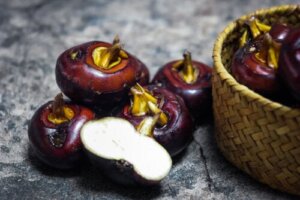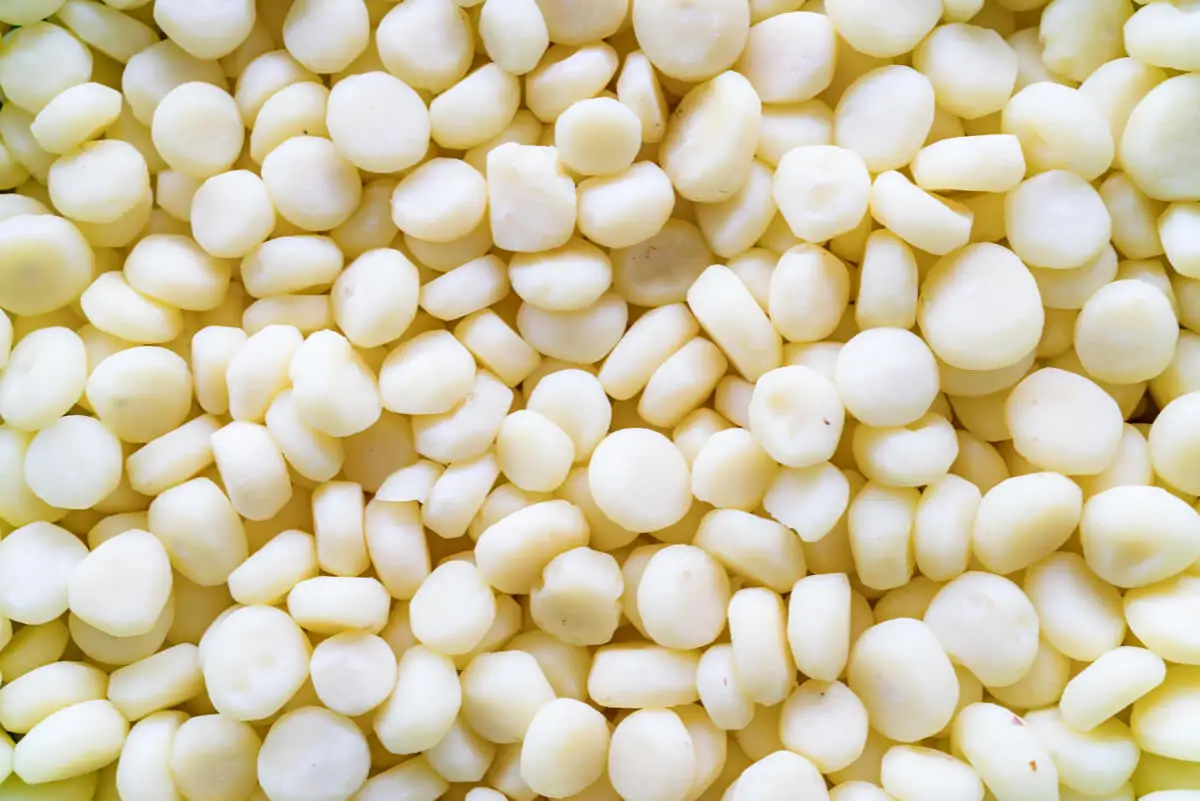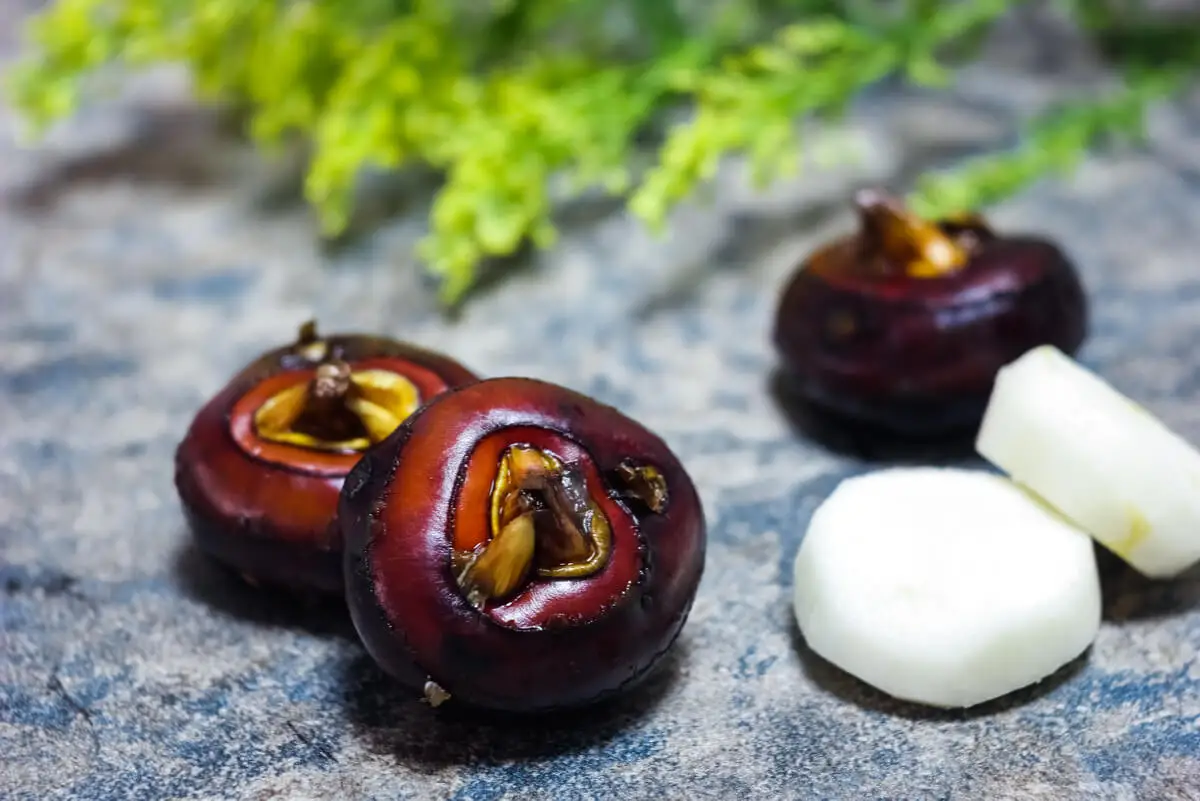What Are Water Chestnuts and How Can They Be Included in Your Diet?


Written and verified by the nutritionist Maria Patricia Pinero Corredor
Trapa is the botanical genus representing water chestnuts, two species of floating plants whose submerged stems grow to a depth of about 5 meters. T. natans and T. bicornis are native to India, Asia, and China. They are cultivated in ponds, rice fields, lakes, and shallow marshes.
Their fruits are protected by the sepals of the flower, which form robust and hard spines, similar to a bull’s head. They store a seed with high starch content inside.
The Royal Botanical Garden of Madrid describes them as sweet and floury, used as raw material in East Asia to make cookies, infant formulas, flours, and as an ideal substitute in gluten-free diets.
Interested in learning more about this curious fruit? Join us to discover everything you need to know about water chestnuts!
The origin and history of water chestnuts
The name derives from the Latin trappa, which means ‘thorny trap,’ due to the thorns of its fruits that resemble an ancient war machine. In the 2nd century B.C., during the Zhou dynasty in China, water chestnuts already appeared in religious ceremonies.
In 1694 it was part of a Chinese medicine herbarium and in 1880 it spread as an ornamental plant in Europe. Later, it was used as part of the diet until the beginning of the 20th century. However, it’s almost extinct, especially in Spain.
In the United States, it arrived in 1874 and in some of its regions, it’s considered a noxious weed, such as in Australia and New South Wales.
The nutritional values of water chestnuts
The United States Department of Agriculture established the macronutrient values of the water chestnut in grams per 100 grams of fruit. The Indian Department of Pharmacy published the vitamins and minerals in milligrams:
- Water: 74 %
- Protein: 1.43 %
- Starch: 15,71 %
- Fiber: 5,7 %
- Fat: 0,1 %
- Total sugars: 2,86 %
- Energy: 64 calories
- Beta-carotene: 60 micrograms %
- Potassium: 5.22 milligrams
- Phosphorus: 6.77 milligrams %
- Iron: 200 milligrams per kilo
- Zinc: 600 milligrams per kilo
- Manganese: 430 milligrams per kilo
Water chestnut fruits contain no fat or cholesterol, and protein is found in low proportion. The nutrient that stands out most is starch, used to make derived flours and as a thickener.
A review on fiber emphasizes its benefit in lowering the risk of chronic diseases, such as cardiovascular disease, diabetes, and obesity. Water chestnuts are also a good source of zinc, manganese, iron, and potassium.
According to the Spanish Nutrition Foundation, these micronutrients have benefits on metabolism and the immune system, as coadjuvants of enzymes. They are also involved in muscle contraction.
Vitamin A is found in the form of beta-carotene, which, according to published reports, is essential for night vision, growth, development, and immune function.

The health benefits of water chestnuts
Water chestnuts provide multiple health benefits. These are some of them that we systematize in this section.
Antioxidants and water chestnuts
The journal Molecules published that water chestnuts contain a group of polyphenols, such as ferulic acid, gallocatechin gallate, epicatechin gallate, and catechin gallate, which act as potent antioxidants.
In vitro laboratory tests, reported by the journal Journal of Food Science, Dr. Patricia Herrera comments that free radicals activate oxidative stress and increase the risk of degenerative diseases, such as atherosclerosis, type 2 diabetes, and even certain types of cancer.
They’re ideal for low-calorie diets
Water chestnuts contain no fat, and this considerably reduces calorie intake. A 70-gram serving provides only 45 calories.
In addition, Rolls and other authors concluded that foods with high levels of water are more effective in reducing energy intake. These chestnuts have more than 70% moisture, which produces high volume and satiety.
We think you may be interested in reading this, too: Pine Nuts: Nutritional Value, Benefits and How to Eat Them
They help control blood pressure
These little fruits contain a good proportion of potassium, a mineral involved in fluid control within the cell and muscle functionality.
A review in Advances in Nutrition emphasizes the relationship of potassium with the reduction of blood pressure and decreased risk of cardiovascular disease. It’s therefore recommended to eat foods rich in this mineral.
They could be adjuvants for cancer treatment
Some laboratory studies were able to suppress tumor growth and caused the death of cancer cells. This is in response to ferulic acid.
This is the highest concentration antioxidant in water chestnuts. Other similar results were observed in in vitro assays on skin, lung, bone cell, and thyroid cancers.
A review on this topic links the growth and spread of cancer cells to free radicals. So, when antioxidants neutralize them, they can limit cancer growth.
However, so far, we only have laboratory results in vitro. Therefore, studies on real cancer patients are needed to give accurate recommendations on these antioxidants. In no way are water chestnuts a first-line oncological treatment.

Like this article? You may also like to read: Did You Know that Dried Fruit and Nuts can Help You Lose Weight?
How can water chestnuts be prepared?
Water chestnuts can be tasted in many ways. This ranges from raw, as an appetizer, to fried, grilled, candied, pickled, or even boiled. Whatever way you decide to consume them, they are a real delicacy. You can also buy them fresh or canned in Asian markets.
If you prefer them fresh you should wash and peel them before enjoying the crunchiness of the seed. According to some authors, this is due to their antioxidants. When boiled or fried, they maintain a crunchy texture similar to apples. When diced, sliced, or grated, they can be part of omelets, salads, curries, chop suey, and sauces.
As a practical alternative, water chestnuts are also prepared as flour alone or mixed with corn, wheat, or potato flour. They are used to make bread, gluten-free cakes, cookies, and crispy puff pastries, among other things. You can keep them in the fridge or freezer.
Sing and David show us a delicious recipe for water chestnut pudding. For 1 liter of whole milk, after boiling and resting, add 200 grams of water chestnut flour, 300 grams of honey, and 20 grams of cocoa powder. This is cooked for 6 minutes until the consistency is reached. This should be served cold.
What to remember about water chestnuts
Water chestnuts are aquatic fruits rich in starch, fiber, vitamin A, and minerals. Their antioxidants may prevent certain diseases related to oxidative cellular stress caused by free radicals. Although more studies are needed on their effect on humans.
In addition, in cooking, they’re suitable for low-calorie and gluten-free diets. Their nutritional and health benefits can be savored by incorporating them fresh, canned, or in flours.
All cited sources were thoroughly reviewed by our team to ensure their quality, reliability, currency, and validity. The bibliography of this article was considered reliable and of academic or scientific accuracy.
- Adkar,P., Dongare,A., Ambavade, S., and Bhaskar, V. Trapa bispinosa Roxb.: A Review on Nutritional and Pharmacological Aspects. Advances in Pharmacological Sciences. 2014, Volume 2104, 1-13 pages.
- Cirujano, S., Meco A., García P., Chirino, M. Flora acuática española. Hidrófitos vasculares. Real Jardín Botánico. CSIC. Madrid. 2014, 1-321 páginas.
- Anderson JW, Baird P, Davis RH Jr, Ferreri S, Knudtson M, Koraym A, Waters V, Williams CL. Health benefits of dietary fiber. Nutr Rev. 2009 Apr;67(4):188-205.
- You, Y., Duan, X., Wei, X., Su, X., Zhao, M., Sun, J., Jiang, Y. (2007). Identification of Major Phenolic Compounds of Chinese Water Chestnut and their Antioxidant Activity. Molecules, 12(4), 842–852.
- Gupta RK, Patel AK, Shah N, Chaudhary AK, Jha UK, Yadav UC, Gupta PK, Pakuwal U. Oxidative stress and antioxidants in disease and cancer: a review. Asian Pac J Cancer Prev. 2014;15(11):4405-9.
This text is provided for informational purposes only and does not replace consultation with a professional. If in doubt, consult your specialist.








